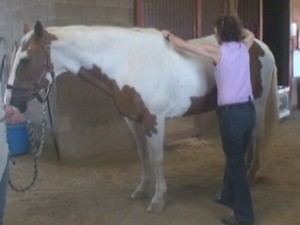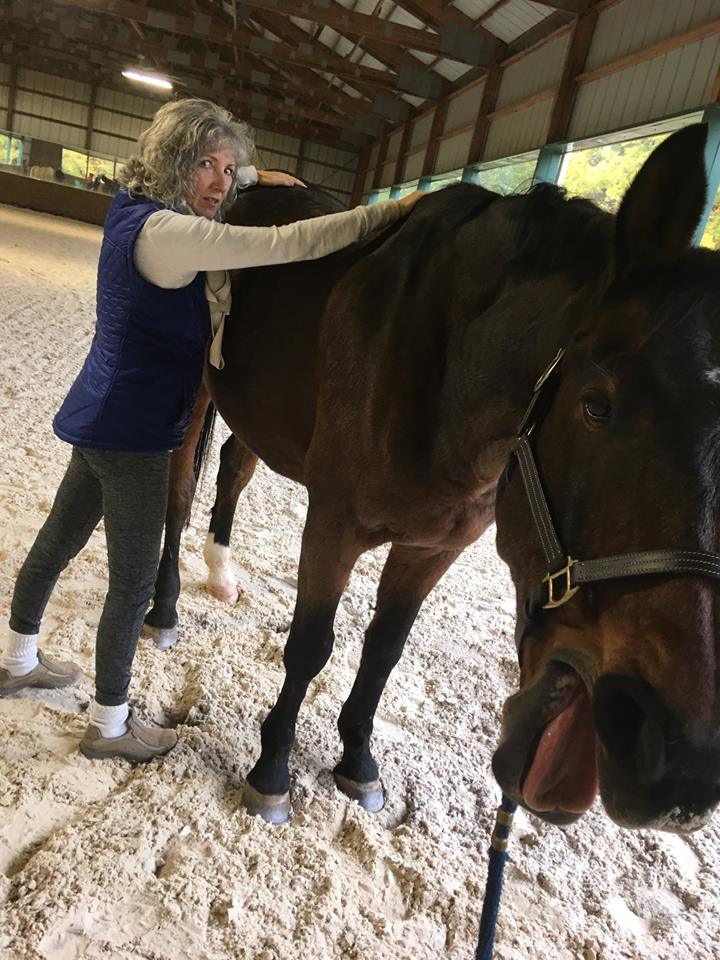Finding Equine Ease: Rocking Away Tension and Discomfort
Sep 03, 2023
Benefits of Rocking:
- Reduces neuromuscular tension
- Calms your horse and acquaints them to your touch
- Shows where your horse may be restricting movement
- Improves body awareness, balance and coordination of you and your horse
- It can be a RESET for the nervous system
- Gives the horse new possibilities for movement without awakening the body's defenses
Why Rock Your Horse?
Rocking has many benefits - for you and your horse.
It’s a great way to CONNECT with your horse and improve awareness for both horse and human if it’s done with a high degree of attention and a low degree of effort. You and your horse can really tune into each other.
Rocking can be a great way to mentally and physically prepare you and your horse for a ride, groundwork, or more Debono Moves hands-on work.
Read how simple Rocking and Muscle Lifts helped a sore, tight gelding rediscover easy, comfortable movement.
Hawkeye's Story
The palomino gelding was gently led into the barn by his owner, Catherine, who had acquired the five-year-old gelding just six months earlier. Although a veterinarian had initially cleared him for purchase, Hawkeye was never quite right. He moved with a short, tentative stride. Even at rest, he seemed uncomfortable, constantly shifting his weight from one diagonal to the other.
Over the previous six months, Hawkeye had been examined by three veterinarians, all of whom had concluded that the horse was chronically muscle sore and likely had navicular syndrome.
With a possible diagnosis in hand, treatment was initiated, but Hawkeye's movement and comfort level remained unchanged. When Catherine learned that I was conducting a Debono Moves workshop in her area, she brought Hawkeye, hoping that we could help him feel better and move more easily.
Wendy, one of the workshop participants, was assigned to work with Hawkeye. Despite his good-natured and quiet disposition, the palomino proved challenging. Every time Wendy attempted to touch him, he would shy away, as if fearing that her contact would worsen the soreness he felt.
A nervous system affected by pain and tension, as in Hawkeye's case, is unlikely to learn and improve. Such a nervous system is constantly preoccupied with defending itself against the threat of further discomfort, making it difficult to process new sensory information, while ongoing muscular contractions drown out other sensations. I refer to this as a "noisy nervous system."
Wendy's initial step was to calm Hawkeye's nervous system by eliminating the background noise of chronic muscular tension and anxiety. This would allow the horse to experience the possibility of feeling differently. In simpler terms, quieting the nervous system creates the conditions for learning and improvement to take place.
Based on my experience, many horses that dislike being touched will tolerate contact with bony areas, such as the withers. Skeletal contact is generally less threatening to them, especially when they have a history of sore muscles.
Understanding this, Wendy gently placed her hand directly on Hawkeye's withers and began to lightly rock him back and forth, using the gentlest possible movements. During the Debono Moves workshop, she had observed how rhythmic rocking helped many horses release unnecessary muscular contractions.
 Mary rocking Scout (not Wendy and Hawkeye)
Mary rocking Scout (not Wendy and Hawkeye)
Wendy's intuition proved correct because Hawkeye not only accepted this contact but also visibly relaxed, lowering his head and partially closing his eyes, with tension around his mouth and nose dissipating. It seemed that the rhythmic oscillations interrupted Hawkeye's usual pattern of muscular tightening.
Catherine was pleasantly surprised by the change in her gelding's behavior. For six months, he had resisted human contact, and even the gentlest grooming with brushes had met with displeasure. So this breakthrough was significant!
After gently rocking him from the withers for a short while, Wendy placed her other hand on Hawkeye's croup and rocked him from both places simultaneously, with Hawkeye appearing content throughout.
Wendy wanted to support the gelding's overworked muscles by gently lifting and holding them. However, if she stopped the light rocking movements, Hawkeye became agitated. So, while using one hand to continue rocking Hawkeye from the withers, she placed her other hand gently on the horse's right shoulder. It required some coordination to maintain a steady rocking rhythm, but Wendy began to slightly lift Hawkeye's tight shoulder muscle. The rhythmic rocking helped soothe Hawkeye and reduce his tendency to tighten his muscles.
Once Hawkeye had grown comfortable with her touch, Wendy gradually ceased the rocking movements and placed both hands on the horse's shoulder muscle, about a foot apart. She delicately and slowly brought her hands together, slightly shortening the muscle. Her intention was to relieve the horse's effort. Wendy used her hands to provide support to a muscle that was overworking, thereby rendering Hawkeye's muscular contractions unnecessary.
This approach serves two purposes: first, it gives the horse the sensation that someone else is doing the muscle work, allowing the continuous contractions to cease; and second, it brings awareness to an area that may have been "tuned out" and lost from the horse's body awareness.
Once Wendy felt the muscle soften, she gradually released it, being careful not to abruptly withdraw her support. She then moved her hands a few inches over and repeated the process. Throughout, she remained attentive to Hawkeye's reactions. As long as he stayed calmly engaged, she would continue. However, if Wendy noticed an increase in anxiety, indicated by shallow breaths, a tightening of the mouth, or a flattening of his ears, she would return to rocking him and supporting an area she knew he was comfortable with.
It's crucial to note that Debono Moves engages horses in the process of learning how to move more comfortably and efficiently. Wendy's intent was not to manipulate Hawkeye's muscles but to make him curious about how his body felt and moved, enhancing his awareness.
She aimed to increase his awareness of all the different parts of himself, as a tendency to tighten muscles unnecessarily often indicates that these areas have been "tuned out" or lost from the horse's body self-image. Keeping the movements pleasurable is essential to this process.
Wendy worked slowly and alternated between rocking and holding various muscles. Sometimes she did both simultaneously, using one hand to rock Hawkeye while gently lifting a muscle with the other. Wendy softly lifted Hawkeye's rock-hard forearm muscles with both hands and then slightly rolled them in the direction they moved most comfortably. Her goal was to help him feel how these muscles could soften and slide. Wendy continued lifting muscles along Hawkeye's body, and she was pleased to feel his muscular tension continue to release under her touch.
But even more satisfying was that Hawkeye had repositioned himself into a comfortable-looking, square stance. He no longer constantly shifted his weight, trying to find a comfortable position. Instead, he was now comfortable because his muscles were no longer working against him. His muscles could contract when needed and relax when at rest. In addition to having freer movement, Hawkeye's energy level and attitude would undoubtedly improve as a result.
Hawkeye was now ready to learn how to move more freely. Wendy touched and moved the gelding in specific ways to help him understand how his different parts could work together smoothly. This would allow his nervous system to form new neural connections, enabling more comfortable and efficient movement.
When Catherine walked Hawkeye after his session, the mincing, painful-looking steps were gone. Instead, the palomino gelding moved confidently, with his hind feet overreaching beyond the hoofprints left by his forefeet. Catherine was nearly in tears. In fact, the entire class, including myself, was pleasantly surprised by how much Hawkeye had transformed in such a short time, especially considering Wendy was a novice student in my clinic!
Catherine stayed in touch for a while, reporting that Hawkeye's improvement was evident under saddle as well. His stride was longer, and he moved forward willingly. He was more confident in his body. I encouraged Catherine to continue working with her vet and farrier to fully support Hawkeye's recovery.
Witnessing his transformation had given Catherine a renewed sense of optimism about her horse, and the hands-on work she had learned helped strengthen their bond as well.

Dez and Max enjoying Rocking at a Debono Moves workshop
🐴❤️
xo, Mary
Want more? Easily improve your movement and position in our FREE rider masterclass.
Feldenkrais® for Riders videos: https://www.marydebono.com/rider
All information is for general educational purposes ONLY and doesn't constitute medical or veterinary advice.

